I swear this blog isn’t going to turn into an endless series of lists, but this idea appealed to me. The ambient genre wasn’t really “born” till the 1980s, when the term became widely used. New Age was already basically in existence, ambient music’s maligned sibling. Though as we all know, the lines between the two are often blurred. Ambient was born, really, from experimentation with new technologies in the 1970s as well as the absorption of new musical influences from other genres and places. Drones, once limited in Western music to avant garde tape loop compositions, now became accepted in the post-hippie world. Krautrock bands, raga-rock bands and other experimental rock musicians stretched the limits of their compositions, jamming as long as they pleased. Lonely keyboard players with access to the newest gear sat around noodling and meditating and inventing. Visionaries like Eno and Fripp started theorizing about the ideal music of the technological future.
And thus, this music that we so love started to evolve and diversify into what we know today. Now, there are ten albums on this list, but this is not a definitive recounting by any means — I make no such claim. But each of these albums represents either an influential milestone or a lesser-known step on the road to the development of ambient music as a thriving genre.
I left Music for Airports off, because, like, duh…
Click on the album title for a link to some listening, if you are not familiar with these recordings.
(Also, you can listen to a mix of music from these albums as you read.)
(AND read 10 more classics from the dawn of ambient music!)
Klaus Schulze – Timewind (1975)
One of German keyboard pioneer Schulze’s best-known albums, Timewind is comprised of two side-long pieces. I prefer his earlier, creepier, organ-based stuff myself, but you could hardly expect a fella to resist the lure of all those new synths, could you? Like Tangerine Dream in that period, Schulze discovered the sequencer and uses it to classy, subtle effect on this album, which has lots of pads and “string-synths” as well. How is it ambient? The emphasis on atmosphere instead of melody and the langorous length of the pieces were quite influential on other synthesists of the time and subsequently.
Tangerine Dream – Phaedra (1974)
Much like Schulze, T-Dream had been a highly experimental combo making the most of the limited technologies available (see my review of Zeit). Once synths and sequencers became more available, T-Dream was all over them and became quite possibly the most successful electronic music act of all time — at any rate, one of the most prolific. Phaedra sold a boatload of copies for Virgin and really opened people’s ears to the potential of synthesizers and instrumental, cinematic music in general. Maybe too busy-sounding ultimately to lump in with today’s ambient music but definitely a solid root of the genre.
Robert Fripp – Let the Power Fall (1981)
After the Red album (which is an incredible record), Fripp dissolved King Crimson because he was convinced that the approaching future would not require the services of bloated rock bands. Instead, the musician of the future would use the personal technologies available to him to be a one-man band. Well, Fripp was ahead of his time, but probably 15 years ahead of it. This is an album of Frippertronics, a tape loop system designed to allow him to layer his guitar over and over, creating textured pieces that develop over several minutes of looping. The system was not as smooth-sounding as it later would be, and some of the pieces start rather harshly before the layers start to blend and become softer, but it’s a fascinating recording and definitely a forbear of today’s guitar ambient and any looping system.
Ashra – New Age of Earth (1976)
Like Fripp, Ash Ra Tempel’s virtuoso guitarist Manuel Göttsching developed an interest in making solo music for the “new age”. He dropped the end of the band’s name for some recordings and also made some on his own (including the very very influential E2-E4). This album has some resemblances to Tangerine Dream and Schulze’s albums but also some softer, more deliberately beautiful space music and some pieces featuring delicate, soulful guitar soloing. A great example of early ambient coming out of the Krautrock movement and an album that doesn’t sound the least bit dated today.
Popol Vuh – In Den Gärten Pharaos (1971)
For Popol Vuh, this was a transitional album between experimenting with early synths and the more organic sound that Florian Fricke would pursue on subsequent releases. This album is notable in ambient music terms for being two lengthy side-long tracks. The title track on side one is very abstract and ominous-sounding and features an early use of field recordings — not at all dissimilar to the stuff I hear coming from netlabels today! Fricke used actual tribal percussion as well, a precursor to Steve Roach’s “tribal” ambient perhaps. The magnificent second side, “Vuh”, is dominated by monolithic slabs of heavenly organ and clashing cymbals.
Steve Roach – Structures from Silence (1984)
(there is no sample from this available, apparently, so you can’t enjoy the glory)
Just about everyone considers this one of the great influential classics and Roach’s first truly great album. Roach himself has become sort of the guru of ambient, an incredibly prolific artist for over 30 years who has a gift for anticipating trends. As noted on ye olde Wikipedia, this is his first “purely textural” album, meaning the pieces are long and are given space to stretch out. The first track, “Reflections in Suspension”, has a certain energy but is quite mournful. The second and third tracks, “Quiet Friend” and the title track are quiet, spacious and repetitive…the very essence of soothing ambient. Basically you can’t call yourself a fan of the genre without owning this one.
Michael Stearns – Morning/Jewel (1978)
Stearns was a contemporary of Roach’s, along with Kevin Braheny and later, Robert Rich, in the development of ambient in America. He later went on to much success scoring such films as Chronos and Baraka. This early work is another example of very effective use of field recordings, that staple of modern ambient. It’s also a wonderful demonstration of the Serge synthesizer. The environmental sounds, which are not mixed very low, mix with the textures of the synthesizer to make for a hypnotic listening experience. There’s some traces of Terry Riley’s style in there too (dang, I should have included Riley on this list…next time). “Morning” is the louder piece, while “Jewel” is very textural.
Iasos – Angelic Music (1978)
You may not have heard of this one. Iasos, a Greek-American whose music came out of the burgeoning California New Age movement, is usually associated with New Age music (I mean, the album title should be a clue!), but in fact this two-track album is a wonderful example of drone ambient. Steve Roach didn’t come close to doing anything like this till at least the mid-80s, and most of the “drift” ambient I hear coming from netlabels sounds exactly like what Iasos achieved so strongly on this recording. I’d say it was way ahead of its time.
Diatonis – Landscape of a Dream (1984)
Another lesser-known artist, New Zealand-based (I think) Diatonis released this then it seems disappeared for a long time. I suppose I can’t say this music is particularly influential, but certainly quickly became one of my favourites when I got into ambient music hardcore about 10 years ago. Landscape of a Dream is another prescient album unlike much of what was going on at that time, though Eno’s output would be the closest touchstone. This album is comprised of four celestial pieces based either on drone or on simple, beautiful progressions, with airy pads. One of the finest early ambient albums and one you must have.
Steve Hillage – Rainbow Dome Musick (1979)
Hillage was the guitarist for hippie gods Gong and really got into Daevid Allen’s whole “Pothead Pixie” philosophy. Gong’s music was pretty chaotic and Hillage was a very jazzy guitarist, so it must have surprised a lot of people when he put out this two-track New Age album with his wife accompanying him. The album features some running water sounds, swirly oscillating synths and sequencers, and the distinct sound of “glissando” guitar (a technique he borrowed from the previously mentioned Allen). Apparently the rediscovery of this album helped set Hillage on a new career path in the 90s doing trance music, and I can see why. Not only is this good but it has a distinct personality often lacking in ambient music.











So lovely to see Ashra listed here. Manuel Gottsching’s second solo outing, “Blackouts”, remains my favourite album of all time since its release in 1977. And I agree that these early works of his don’t sound the least bit dated – this isn’t true of his later work, sadly. Adding drums aged the later output immensely.
LikeLike
Yep, you got it. Much like Popol Vuh’s dance music experiments in the 90s…those didn’t work too well either. These guys sounded better when they were pushing the boundaries, not following the trends. That Ashra album helped me get into ambient music and is a perennial fave of mine.
LikeLike
Just to note that Structures From Silence was from 1984.
LikeLike
Oops! Sloopy journalism! Thanks for pointing it out. It came out when I was 10, not 7!
LikeLike
Oh, you’re a young’n. I was in college…
LikeLike
I don’t feel young…
LikeLike
Pingback: 10 more classics from the dawn of ambient music | Make Your Own Taste·
Pingback: QUIET FRIENDS: A 30th Anniversary Tribute to Steve Roach’s Structures from Silence (2014) | Make Your Own Taste·
Reblogged this on enemymindcontrol.
LikeLike
Phaedra is a monumental/phenomenal/iconic/unique/groundbreaking album. Maybe not ambient in terms of mainstream definitions, but full of ambient cues and devices. This album along with Rubycon and Ricochet were probably the biggest contributors to my subsequent musical preferences and choices.
Ar some time during the last 37 years, I have owned at least 3 of the other albums listed here. I’ll have to hunt them down. Good to see Ashra getting a mention. I used to really enjoy Blackouts too.
Did I really say that?
LikeLike
I never enjoyed a blackout myself but diff’rent strokes!
LikeLike
I really fell in love with Diatonis. Thank you very much.
LikeLike
That is nice to hear, thank you!
LikeLike